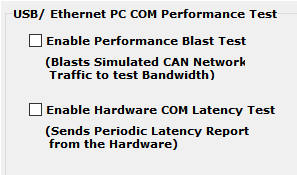5. The neoVI Explorer Configuration Utility¶
5.1. Starting and Using neoVI Explorer¶
The neoVI Explorer utility allows you to connect to, manage and configure all of your Intrepid Control Systems hardware. It is supplied both as an integrated feature of Vehicle Spy, and as a standalone program. This section will describe general features and the basics of using neoVI Explorer, so you will understand the utility when we get into settings specific to your device.
5.1.1. Starting neoVI Explorer from within Vehicle Spy¶
There are several ways to open neoVI Explorer from within VSpy. These are probably the two easiest, since they are accessible at all times:
Menu Item: Click the Setup menu and then select Hardware.
Hardware Setup Button: Click the button located in the main Vehicle Spy toolbar just under its menu (Figure below).

Note
neoVI Explorer cannot be launched when Vehicle Spy is online (even if in simulation mode). If you attempt to do so, VSpy will prompt you to either go offline and launch neoVI Explorer, or remain online and return to Vehicle Spy.
5.1.2. Starting neoVI Explorer as a Standalone Program¶
If you want to work with your device without opening Vehicle Spy, you can launch neoVI Explorer directly. Open the Start Menu, navigate to the IntrepidCS folder, then under the Vehicle Spy 3 sub-folder, select neoVI Explorer (Figure below).
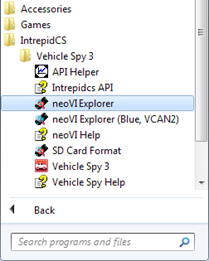
5.1.3. Starting neoVI Explorer as a Standalone Program (API Kit Installed)¶
If you installed the API kit and support files instead of Vehicle Spy, you can run neoVI Explorer from the Start Menu using the same basic process as described above. The only difference is the name of the sub-folder, so you will navigate to the IntrepidCS folder, then open the ICS API Install Kit sub-folder, and finally select neoVI Explorer (Figure below).
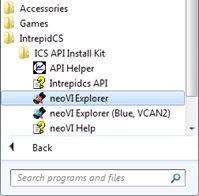
5.2. Interfacing with your device¶
5.2.1. Connecting to your device¶
When neoVI Explorer loads, it will start up with the first hardware device it can find selected in the menu pane on the left. You should see your device listed here, along with its serial number. If you don’t see the device to be connected, but do see other Intrepid devices, be sure to scroll down to look for it. If it is still not visible, this means its drivers have not been installed correctly, it is not powered properly, or there is a problem with the USB connection.
To manage your device, click on its entry in the navigation pane (if it is not already highlighted) and then press the Connect button. After successfully connecting to the device, you will see a “thumbs up” icon next to the device’s name, and checkmarks will appear next to currently-enabled networks in the explorer area on the left. You should also see a message in the message box on the right saying “<Your Device and Serial Number> settings have been read”. This tells you that neoVI Explorer has loaded the current settings from the unit.
The screen as a whole should appear similar to the screen shown below (but note that the device and version number shown below may be different).
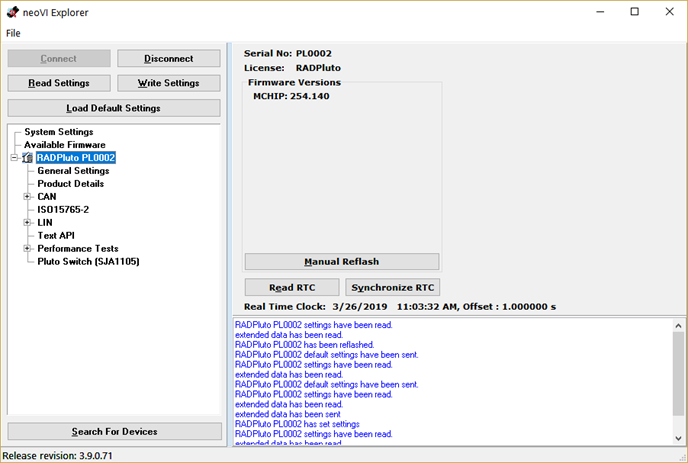
Searching for Devices¶
If you attach new hardware to your PC after starting neoVI Explorer, press the Search For Devices button at the bottom left of the dialog box to prompt the program to scan for new hardware you can manage.
Note
It is possible to click on various parameter groups at any time, but they will not show valid date until you connect to the device. Remember also to connect to the device before making changes, or they will be erased when you do connect to the settings in the hardware are
5.2.2. Device Configuration¶
Writing and Reloading Settings¶
To avoid potential problems, neoVI Explorer will not save any changes to device parameters until you instruct it to do so. This is done by pressing the Write Settings button, which will update the parameters within the firmware in your device. If you make changes you do not want to keep, pressing the Read Settings button will reload the settings stored in the device, wiping out any modifications made in neoVI Explorer that had not yet been saved.
Reloading Device Defaults¶
To return all settings to factory defaults, press the Load Default Settings button. This is convenient if many changes have been made and written to the firmware in the past, and you want to start over with a clean slate. Note that pressing this button actually writes the defaults to the device first, and then reloads them automatically, so you do not need to also press Write Settings. You will see messages in the message area telling you that defaults have been sent to the device and then read from it.
Disconnecting from the device¶
Press the Disconnect button to tell neoVI Explorer that you are done working with the device. This step is actually optional, because neoVI Explorer will disconnect from any connected devices when you exit the program.
Exiting neoVI Explorer¶
Like any Windows program, you can close neoVI Explorer by clicking the “X” in the top right corner, or pressing the Alt+F4 key combination.
5.3. System Settings and Firmware Updates¶
The top two entries in the explorer window on the left side of neoVI Explorer contain system- wide settings that apply to all hardware devices, and information related to firmware updates.
5.3.1. System Settings¶
In the top branch of the tree in the left pane of neoVI Explorer you will see several settings that you can enable or disable:
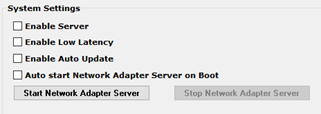
Enable Server: Turns on the neoVI Server feature, a background program that allows your hardware to be used by multiple applications at the same time.
Enable Low Latency: This is an advanced setting for applications where fast response is needed after transmission.
Enable Auto Update: When enabled, both neoVI Explorer and Vehicle Spy will automatically update firmware. If this box is not checked, firmware must be updated manually. (See below for details.)
Network Adapter Server: This is a feature that is used with Intrepid products having Ethernet ports. (It may not apply to your device.) With This feature enabled, the Ethernet ports on your Intrepid hardware will enumerate as network interfaces in the operating system of your host computer. This server can be started and stopped in this window. There is also a checkbox to configure the server to start after booting your computer.
5.3.2. Available Firmware¶
This is an informational page that shows which firmware versions are available in this version of neoVI Explorer for various Intrepid products. Note that some devices have multiple firmware programs that control different aspects of their operation; You normally won’t need to look in this area, because as we’ll see in Section , neoVI Explorer shows you the current and available firmware versions for your device when you connect to it.
5.3.3. Automatic and Manual Firmware Updates¶
Warning
While your device may appear to operate with incompatible firmware, proper and reliable operation cannot be guaranteed unless the version of firmware matches what is listed in Vehicle Spy
Firmware is essentially software that runs hardware and is required to enable the many capabilities of your device. New versions of firmware are created regularly by Intrepid’s engineers to implement new features and correct problems that have been identified.
If you have Enable Auto Update on—which is the default, and is recommended—then you don’t really need to worry about firmware updates. Each time you connect to your device in neoVI Explorer or go online with it in Vehicle Spy, the firmware will be checked, and if a newer version is available, the device will immediately be updated. If you do not have automatic updates enabled, you control when your firmware is updated. When new firmware is available, you will be notified on the initial connection screen, as shown below. Simply press the Manual Reflash button to update the firmware.
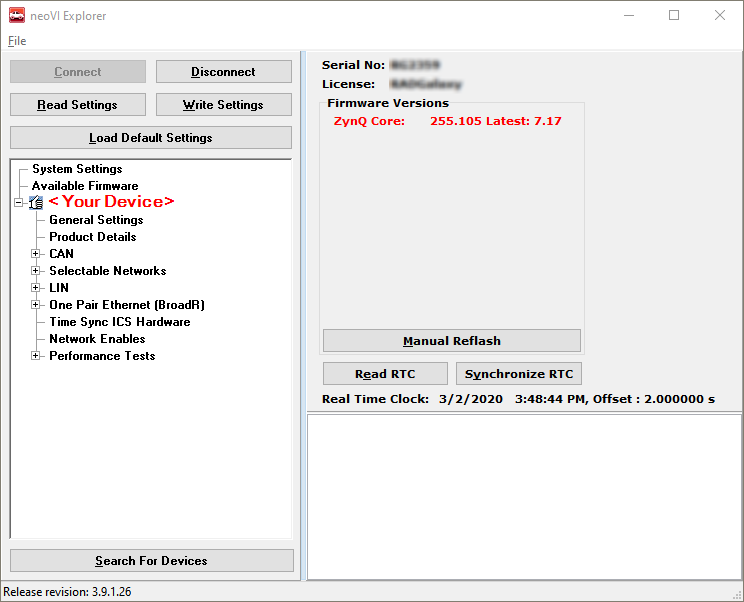
5.3.4. The Firmware Update Process¶
During the firmware update process, the device will be placed into bootloader mode, indicated by all LEDs on the top label flashing synchronously. Normal LED flash patterns will resume when the update is complete and the device reboots. You will see a dialog box on the screen showing you the progress of the firmware update operation. an example is shown below. You will also see messages in the message box on the right side of neoVI Explorer as the firmware program is sent to the device. When the process is complete the dialog box will disappear and another message will appear in neoVI Explorer to confirm that the update has finished. If you receive any error messages or experience any other problems updating your device’s firmware, please contact Intrepid for assistance.

Warning
Please take heed of the warning on the firmware update dialog box: leave the device connected and powered on for the entire firmware update process to avoid possible problems with the device.
5.4. General Settings and Product Details¶
These two areas of the device’s parameter setup provide information about the device and allow you to perform a few basic maintenance tasks.
5.4.1. General Settings¶
After connecting to the device you will see basic information about it in the right-hand pane of the window:
The device’s serial number.
The firmware versions currently in the device, and an indication if new firmware is available.
A message showing that the hardware license for the device was recognized.
A current readout of the device’s real-time clock.
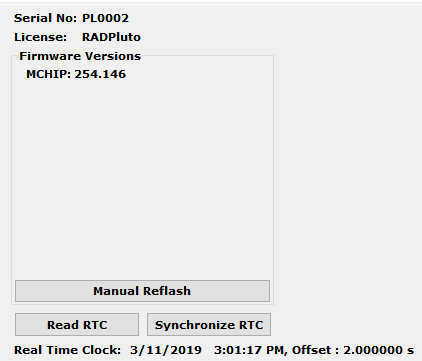
This information can be displayed again at any time by clicking the device’s name in the explorer navigation window, or the General Settings entry immediately below it.
The version(s) of the firmware for the device will be shown in black if it matches the firmware version within neoVI Explorer. If not, the current version and the newest available version will be shown in red to help you notice that an update is available. (See the previous section for more about the update process.)
There are three buttons on this screen.
Manual Reflash (described in the previous section)
Read RTC button will reload the device’s internal time clock
Synchronize RTC will set the device’s clock to the same value as that of the PC.
5.4.2. Product Details¶
This is an informational area that provides technical data on the devices’s hardware and internal setup. You will generally only need this if requested by Intrepid in order to facilitate support or troubleshooting. You can use the Copy To Clipboard button to copy all of the information to the Windows Clipboard, so you can then paste it into an email or file.
5.5. Media Converter Settings¶
The configuration screen below is related to the 2 independent media converters in the RAD-Moon Duo.
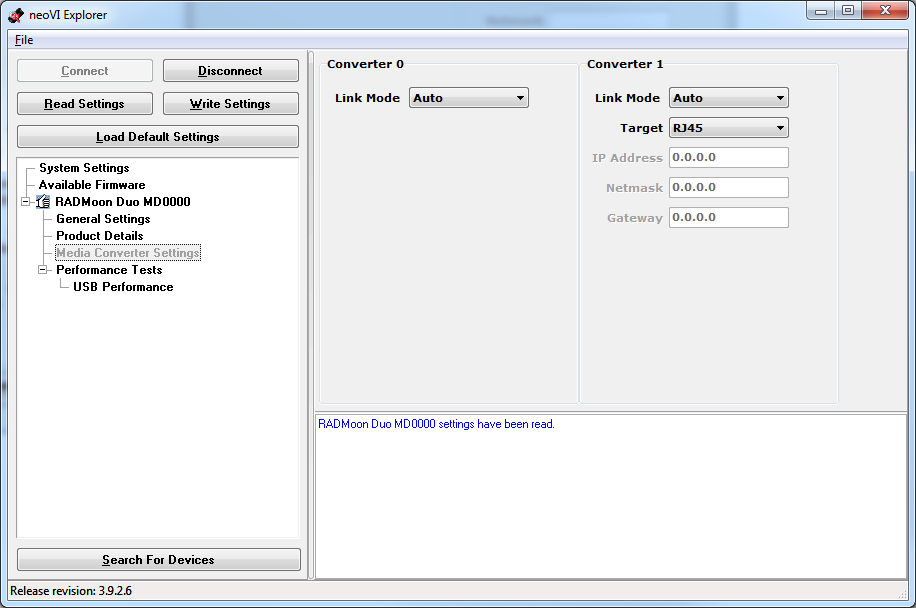
5.5.1. Converter 0¶
This section is with respect to the PHYs connected to AE1 and ETH1.
AE1 Link Mode¶
The link mode of the 100BASE-T1 PHY on AE1 is set with the drop down menu and can be set to auto, master, or slave. (The link mode for ETH1 is alway set to auto.)
5.5.2. Converter 1¶
This section is with respect to the PHYs connected to AE2 and ETH2.
AE2 Link Mode¶
The link mode of the 100BASE-T1 PHY on AE2 is set with the drop down menu and can be set to auto, master, or slave. (The link mode for ETH2 is alway set to auto.)
Target¶
This is in reference to the connection of the 100BASE-T1 PHY on AE2.
RJ45: AE2 is connected to ETH2
USB/CM: AE2 is connected to the CoreMini processor which enables the use of the Core Features of Vehicle Spy and Intrepid’s Open Source Software (In this mode, ETH2 is disabled)
IP Settings¶
These settings are currently not used.
5.6. Performance Tests¶
The following are tests which can be used to characterize the bandwidth and latency between ICS hardware and its host computer. If you suspect you have a problem with either of these, our customer support would be happy to help resolve it. Reference the end of this document for contact information.
